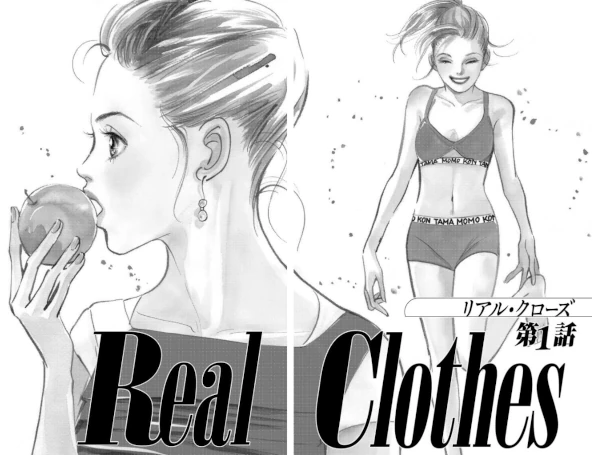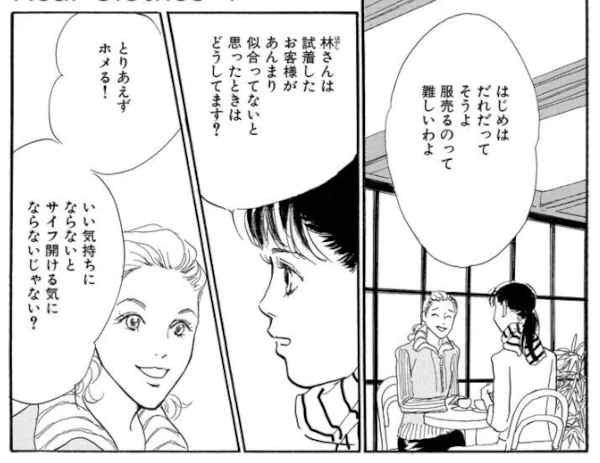This time, we’re introducing Real Clothes—a manga that beautifully captures the challenges and growth of a working woman, while offering authentic examples of business Japanese.
Work Information

Real Clothes
Author: Makimura Satoru
Publisher: SHUEISHA
Amount of text: plentiful
Challenge level: ★★★
Latest volume : Vol.13(Nov.2011 / Completed)
Story overview
In her fifth year at a major department store, 27-year-old Kinue Amano suddenly receives an unexpected transfer—to the women’s clothing section! She had always believed that “fashion is just decoration—a thin layer on the surface of life.” But now, in the highly competitive Shinjuku branch of the prestigious “Echizenya” department store, her beliefs are about to be challenged. As Kinue navigates this dramatic career shift, her work, relationships, and self-expression intertwine, testing her values and revealing her true potential.
The Appeal of This Manga
First serialized in 2006 by veteran manga artist Satoru Makimura, Real Clothes remains strikingly relevant even nearly two decades later. Its enduring appeal lies in its honest depiction of human nature and professional life. The story follows a woman in her late twenties as she struggles, grows, and learns through her work and relationships—portraying these experiences with realism and emotional depth. Readers, regardless of gender, will find themselves reflecting on their own careers and life choices. (The manga was also adapted into a Japanese TV drama.)

Why this manga is suitable for learning Japanese
This manga is not only entertaining but also highly recommended for Japanese learners for several reasons.
Rich Examples of Professional Keigo (Polite Speech)
Set in a high-end department store, this manga offers numerous examples of real, professional Japanese. You’ll find natural dialogues that showcase the use of keigo (honorific and humble forms) in customer service, workplace communication, and interactions between superiors and subordinates. Makimura’s refined and precise writing style further enhances the linguistic value—making it an excellent reference for learners who want to polish their business Japanese.

Expressing Opinions Politely
Many characters are assertive and unafraid to express their thoughts, which makes the manga especially valuable for learning how to voice opinions respectfully in keigo. Because of its nuanced and text-heavy dialogue, however, this title is best suited for advanced learners.

Culture Spotlight
From Children’s Stories to Lifelong Culture: How Manga Grew Up with Its Readers青年向け・女性向けマンガ
In the years following World War II, manga emerged as a form of inexpensive entertainment for children. Artists like Osamu Tezuka pioneered cinematic storytelling styles and imaginative worlds that inspired an entire generation. Early manga were sold in cheap magazines or rental shops, and their bright characters and simple moral tales were designed to delight a young audience.
At this stage, manga was considered something you would “grow out of.” It was a pastime for childhood, much like toys or picture books—fun, emotional, but not something adults were expected to keep reading.

Growing Together – Readers Mature, Writers Mature
As Japan entered the era of rapid economic growth in the 1950s–70s, the children who grew up with Tezuka’s stories became teenagers and young adults. They carried with them both nostalgia and an appetite for deeper, more complex narratives.
Manga artists responded in kind. Writers and illustrators, who themselves were aging and refining their craft, began to explore themes of identity, society, love, and work. The result was a natural evolution: manga that grew alongside its readers.
Titles began to appear in new demographic categories—shōnen (boys’ manga) and shōjo (girls’ manga) evolved into seinen (young men’s manga) and josei (women’s manga). Each reflected the changing lives of readers who were no longer children but adults navigating Japan’s modern world.
The Economic Miracle and Cultural Maturity
By the 1980s, during Japan’s economic boom, manga had become a mainstream cultural force. The so-called “baby boomer juniors” (団塊ジュニア世代)—the children of the postwar baby boomers—grew up in a consumer society that treated their tastes as powerful market drivers.
Publishers realized that manga was no longer just a child’s pastime but a profitable medium that could engage readers at every stage of life. Series set in workplaces, politics, romance, and family life flourished. The boundary between “childhood reading” and “adult literature” blurred, and manga became an art form capable of both entertainment and social commentary.
A Dialogue Between Generations
This transformation was not one-sided. As readers matured, so did the creators. Manga became a conversation between generations—between the dreams of youth and the realities of adulthood, between those who drew the stories and those who had grown up reading them.
For example, an author who once wrote about school adventures might later depict the struggles of working life or parenting. Readers could follow these evolving themes as part of their own growth, finding both comfort and reflection in the pages.
What It Means for Learners of Japanese
For learners of Japanese, this evolution of manga is more than just cultural trivia—it’s a window into modern Japanese values. The language in manga mirrors Japan’s changing society: from the simple expressions of childhood to the complex emotional tones of adulthood.
Studying manga across eras helps you see how vocabulary, politeness levels, and even storytelling rhythm adapt to new generations. More importantly, it shows that manga in Japan is not something to “outgrow,” but a lifelong form of cultural expression that continues to grow with its readers.
A Little Warning
Occasional feminine sentence endings (“-wa”, “-wayo”)
From time to time, some older-style feminine endings such as 「だわ」or「わよ」appear in the dialogue. These are classic fiction-style expressions and not commonly used in modern spoken Japanese. They don’t detract from the quality of the story, but learners should simply enjoy them as part of the narrative style—not as phrases to imitate in real-life conversation.

Work Information

Real Clothes
Author: Makimura Satoru
Publisher: SHUEISHA
Amount of text: plentiful
Challenge level: ★★★
Latest volume : Vol.13(Nov.2011 / Completed)
Here’s a safe and convenient way to purchase Japanese manga.
This Blog’s ConceptIn this blog, we are introducing manga that are not only highly captivating but also ideal for Japanese language learners. Studying Japanese through manga is both fun and effective. Manga allows you to understand the subtleties of keigo (honorifics), teineigo (polite speech), and casual conversation in Japanese. We hope you find works that match your interests and use them to enhance your Japanese learning journey.